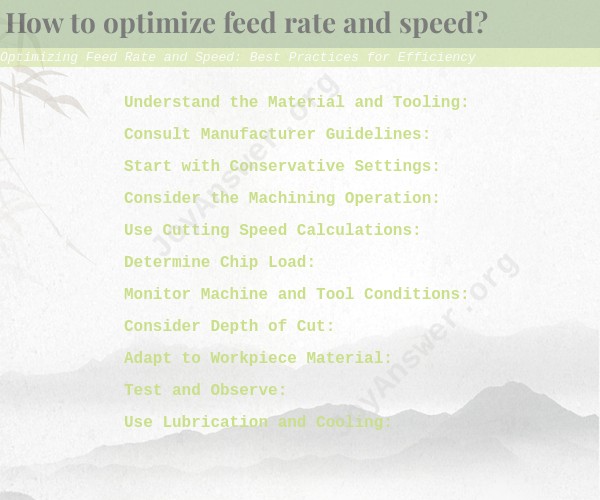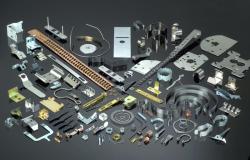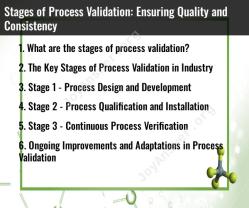How to optimize feed rate and speed?
Optimizing feed rate and speed is essential in various industrial and machining processes to improve efficiency, reduce production time, and achieve better results. Whether you're working with milling machines, lathes, 3D printers, or any other machinery that involves feed rates and speeds, here are some best practices to help you optimize these parameters:
Understand the Material and Tooling:Before setting your feed rate and speed, you should have a thorough understanding of the material you're working with and the type of tooling you're using. Different materials and tools require specific cutting speeds and feed rates.
Consult Manufacturer Guidelines:Most tool and machinery manufacturers provide guidelines and recommendations for feed rates and speeds for their products. Refer to these guidelines as a starting point for your settings.
Start with Conservative Settings:When in doubt, it's often safer to start with conservative (slower) feed rates and speeds. You can gradually increase them as you become more confident in the process and as you observe the results.
Consider the Machining Operation:Different machining operations, such as drilling, milling, turning, and grinding, have unique feed rate and speed requirements. Ensure that your settings are appropriate for the specific operation you're performing.
Use Cutting Speed Calculations:Cutting speed (in surface feet per minute, SFM) is a critical factor in determining the optimal speed for machining. Use the appropriate formula to calculate cutting speed based on the tool diameter and material type. For example, for milling, the formula is: SFM = (3.82 x Tool Diameter x RPM).
Determine Chip Load:Chip load is the thickness of the material removed with each cutting edge engagement. It's calculated as Feed Rate (in inches per minute) divided by the number of cutting edges (e.g., number of teeth on a milling cutter). Adjust your feed rate based on the desired chip load for the material and tool.
Monitor Machine and Tool Conditions:Regularly inspect and maintain your machinery and tooling to ensure they are in good working condition. Dull tools, worn-out parts, or improperly lubricated components can affect performance.
Consider Depth of Cut:The depth of cut, which is how deep the tool penetrates into the material, impacts the ideal feed rate and speed. Deeper cuts may require slower feed rates to prevent tool wear and overheating.
Adapt to Workpiece Material:Different materials (e.g., metals, plastics, wood) have varying hardness and thermal conductivity. Adjust your settings based on the material's characteristics to avoid overheating, tool wear, and workpiece damage.
Test and Observe:Conduct test runs and observe the results. Pay attention to factors like surface finish, tool life, and temperature. Adjust your feed rate and speed as needed based on the outcomes.
Use Lubrication and Cooling:Proper lubrication and cooling are crucial in high-speed machining operations. They help reduce friction and prevent overheating, which can lead to tool wear. Make sure your machines have adequate lubrication and cooling systems in place.
Record and Document:Keep a record of your settings, observations, and outcomes for different materials and machining operations. This documentation can serve as a valuable reference for future projects.
Optimizing feed rate and speed is an ongoing process that requires a balance between productivity and tool longevity. Regularly reviewing and adjusting these parameters based on material, tooling, and machine conditions will help you achieve the best results in your machining or manufacturing processes.
Strategies for Optimizing Feed Rate and Speed in Manufacturing
Optimizing feed rate and speed in manufacturing is essential for achieving high productivity and quality outputs. Here are some strategies to help you achieve this:
- Understand the capabilities of your machines and tools. It is important to know the maximum and minimum feed rates and speeds that your machines and tools can handle. This will help you to avoid damaging your machines or tools and ensure that you are operating within their safe operating limits.
- Use the right cutting tools. The type of cutting tool you use will have a significant impact on the optimal feed rate and speed. For example, carbide cutting tools can handle higher feed rates and speeds than high-speed steel cutting tools.
- Consider the material being machined. The hardness, toughness, and other properties of the material being machined will also affect the optimal feed rate and speed. For example, softer materials can be machined at higher feed rates and speeds than harder materials.
- Start with conservative feed rates and speeds. It is always better to start with conservative feed rates and speeds and then gradually increase them as needed. This will help to avoid damaging your machines, tools, or workpieces.
- Monitor the machining process closely. Once you have started machining, it is important to monitor the process closely. Look for any signs of problems, such as excessive heat, vibration, or chatter. If you see any problems, reduce the feed rate or speed immediately.
Factors Influencing Feed Rate and Speed Adjustments
A number of factors can influence feed rate and speed adjustments, including:
- The type of material being machined. The hardness, toughness, and other properties of the material being machined will affect the optimal feed rate and speed. For example, softer materials can be machined at higher feed rates and speeds than harder materials.
- The geometry of the cutting tool. The geometry of the cutting tool, such as the rake angle and clearance angle, will also affect the optimal feed rate and speed.
- The depth of cut. The depth of cut will also affect the optimal feed rate and speed. Generally speaking, deeper cuts require lower feed rates and speeds.
- The spindle speed. The spindle speed will also affect the optimal feed rate and speed. Generally speaking, higher spindle speeds require lower feed rates and speeds.
- The desired surface finish. The desired surface finish will also affect the optimal feed rate and speed. Generally speaking, higher surface finishes require lower feed rates and speeds.
Balancing Efficiency and Precision in Machining
It is important to balance efficiency and precision in machining. Higher feed rates and speeds can improve efficiency, but they can also lead to lower precision. It is important to find the optimal feed rate and speed that produces the desired surface finish and output quality.
The Role of Cutting Tools in Feed Rate and Speed Optimization
Cutting tools play a significant role in feed rate and speed optimization. The type of cutting tool you use will have a major impact on the optimal feed rate and speed. For example, carbide cutting tools can handle higher feed rates and speeds than high-speed steel cutting tools.
It is also important to use sharp cutting tools. Dull cutting tools can lead to lower surface finishes and reduced efficiency.
Real-Life Examples of Successful Feed Rate and Speed Optimization
Here are some real-life examples of successful feed rate and speed optimization:
- A manufacturer of automotive parts was able to increase production by 20% by optimizing the feed rate and speed of their CNC machining operations.
- A manufacturer of medical devices was able to reduce the cost of manufacturing each device by 10% by optimizing the feed rate and speed of their machining operations.
- A manufacturer of aerospace components was able to improve the surface finish of their products by 50% by optimizing the feed rate and speed of their machining operations.
These are just a few examples of how feed rate and speed optimization can lead to significant benefits in terms of productivity, cost, and quality.
By following the strategies and tips discussed above, you can optimize the feed rate and speed of your manufacturing operations to achieve the best possible results.










